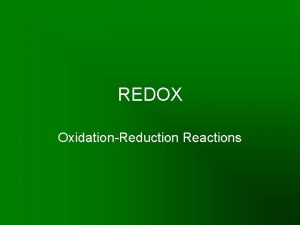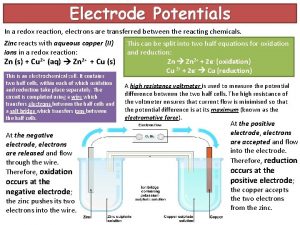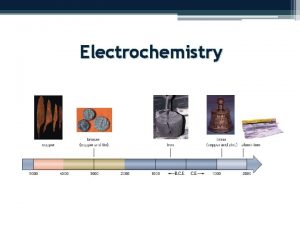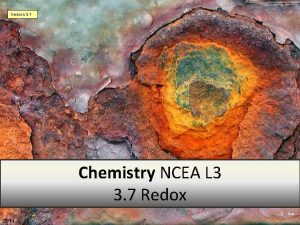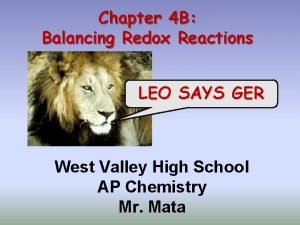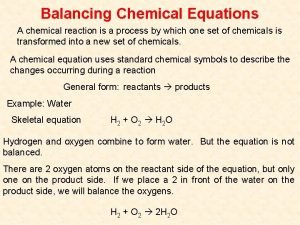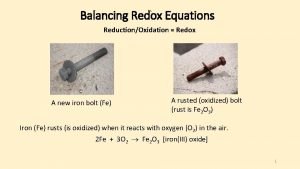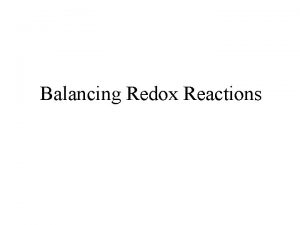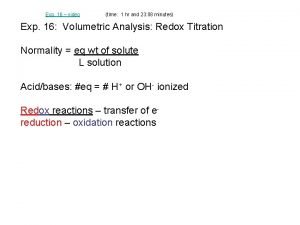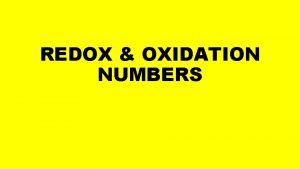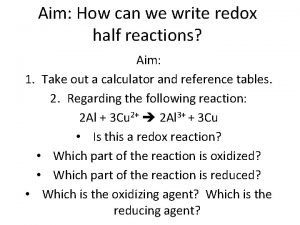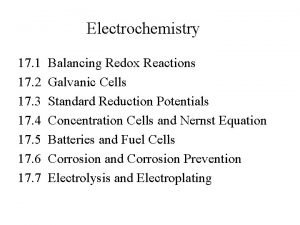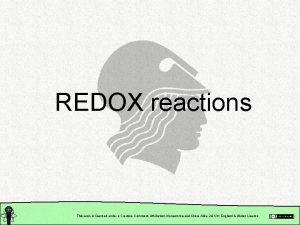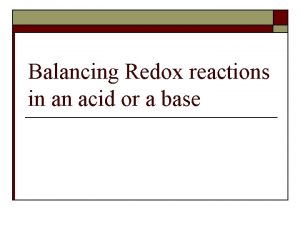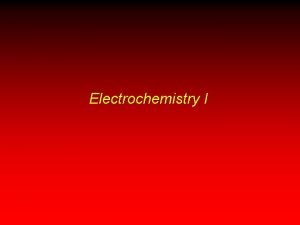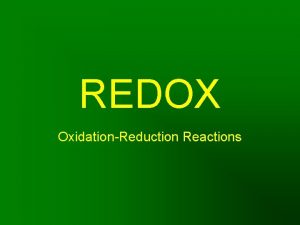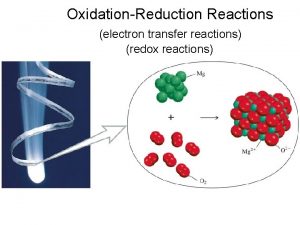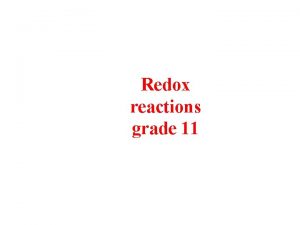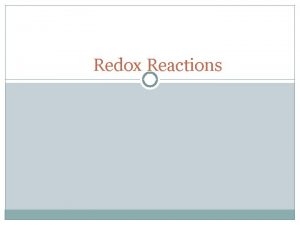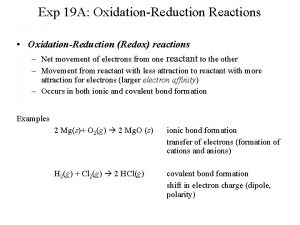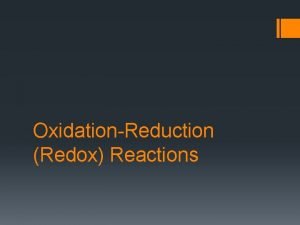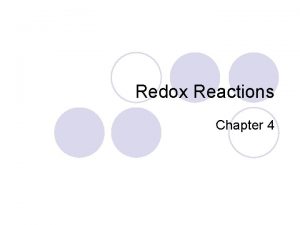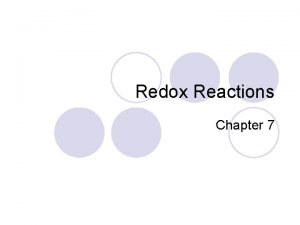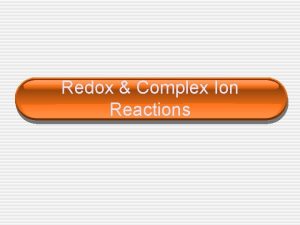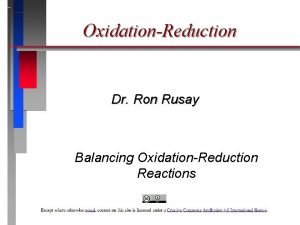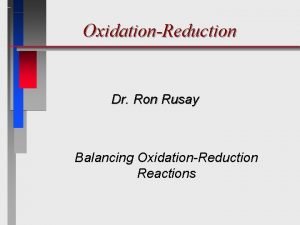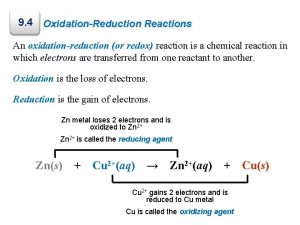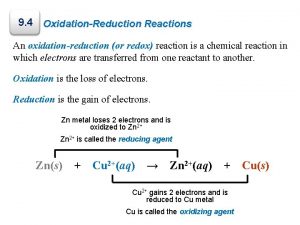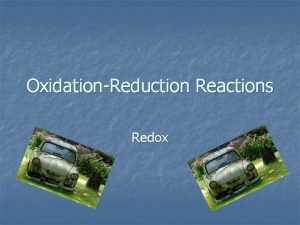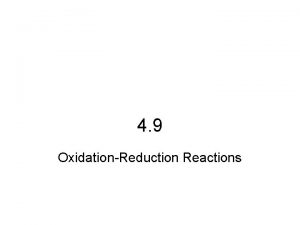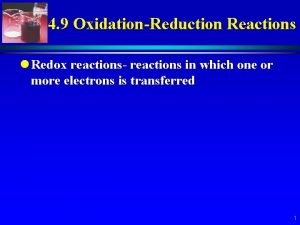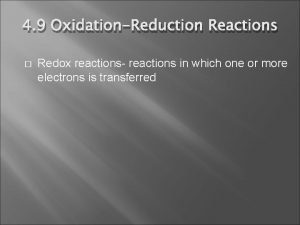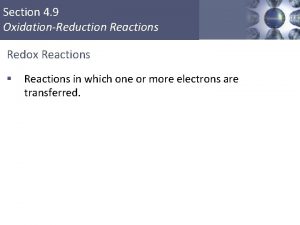REDOX OxidationReduction Reactions OxidationReduction Reactions Electrons transferred from























- Slides: 23

REDOX Oxidation-Reduction Reactions

Oxidation-Reduction Reactions • Electrons transferred from 1 atom to another • Redox reactions: – All single-replacement rxns – All combustion rxns

LEO GOES GER!!!

Oxidation = loss of electrons LOSS of ELECTRONS = OXIDATION LEO

Reduction = gain of electrons GAIN of ELECTRONS = REDUCTION GER

REDOX Oxidation & Reduction reactions are complementary reactions • occur together & simultaneously or not at all

Oxidation Numbers In Ionic Compounds: – # of electrons lost/gained determined by ions that form compound

Assigning Oxidation Numbers

Rule #1: # of free, uncombined element = 0 Na He O 2 N 2 S 8 Cl 2 P

Rule # 2: # of monatomic ion = charge of ion Ca+2 = +2 Cl-1 = -1 Al+3 = +3 [Remember: Ions form ionic cmpds: Ca. Cl 2, Al(NO 3)3, etc. ]

Rule # 3: F is always -1 CF 4

Rule # 4: H is nearly always +1 • except if bonded to metal then -1 H 2 O, HNO 3, H 2 SO 4, Li. H, Ca. H 2, Na. H

Rule # 5: O is nearly always -2 except when: - Bonded to F: O is +2 OF 2 - Bonded to peroxide ion: O is -1 (group 1 & 2 metals only) O 22 -

Rule # 6 for all neutral compounds: Sum oxidation #’s = 0 S H 2 O CO 2 NO SO 3

Rule # 7 Sum oxidation #’s in polyatomic ion = charge of ion Sum in SO 4 -2 = -2 Sum in NO 3 -1 = -1

Rule # 8 Covalent cmpds: oxidation # more electronegative atom = negative charge (as if was ion) *NH 3: N = -3, H = +1 Si. Cl 4: Si = +4, Cl = -1

Assign Oxidation #’s • KCl K = +1, Cl = -1 • Ca. Br 2 Ca = +2, Br = -1 • CO C = +2, O = -2 • CO 2 C = +4, O = -2 • Al(NO 3)3 Al = +3, O = -2, N = +5 • Na 3 PO 4 Na = +1, O = -2, P = +5 • H 2 S H = +1, S = -2 • NH 4+1 N = -3, H = +1 • SO 3 -2 S = +4, O = -2

4 3 2 1 0 -1 -2 -3 -4 2) And if you’re lucky you strike oil & it shoots up 1) You dig down with an oil rig

Electrons are Negative! • Why use the word “reduced” when electrons are gained? Look how oxidation number changes Ex: Cl gains an electron → Cl-1 • oxidation # ↓ from 0 to -1; the # was reduced

Writing Equations • Even though oxidation & reduction reactions occur together we write separate equations for each process – known as Half-Reactions

Reduction Half-Reactions • I 2 + 2 e- 2 I-1 • O 2 + 4 e- 2 O-2 Electrons are gained so put on reactant side! • Half-reactions must demonstrate: – conservation of mass & conservation of charge – # atoms on left must = # atoms on right – total charge on left must = total charge on right

Oxidation Half-reactions • K K 1+ + 1 e • Fe 2+ Fe 3+ + 1 e • Cu 2+ + 2 e- Electrons are lost so they are put on product side! • Total Charge on left = Total Charge on right • # atoms on left = # atoms on right

Vocabulary Interlude Oxidizing Agent: Substance being reduced – Accepts electrons – aids oxidation for another species Reducing Agent: Substance being oxidized – Loses electrons – aids reduction for another species
 In a redox reaction, electrons are transferred
In a redox reaction, electrons are transferred Standard hydrogen electrode conditions
Standard hydrogen electrode conditions Balance redox half reactions
Balance redox half reactions Redox table
Redox table What are redox reactions examples
What are redox reactions examples Redox reactions ncea level 2
Redox reactions ncea level 2 Leo says ger
Leo says ger Electrolytic cells khan academy
Electrolytic cells khan academy Redox rules
Redox rules How to balance an equation step by step
How to balance an equation step by step Rules for balancing redox reactions
Rules for balancing redox reactions Concentration cell definition
Concentration cell definition Half equations worksheet
Half equations worksheet Complex redox reactions
Complex redox reactions 2 exp 16
2 exp 16 Oxidation state
Oxidation state How to write half reactions
How to write half reactions Examples of redox reaction
Examples of redox reaction How redox reactions work
How redox reactions work Balancing redox reactions in acid
Balancing redox reactions in acid Balancing redox reactions
Balancing redox reactions Balancing aqueous solutions
Balancing aqueous solutions Balancing redox reactions
Balancing redox reactions Chapter 19 review oxidation-reduction reactions answers
Chapter 19 review oxidation-reduction reactions answers
